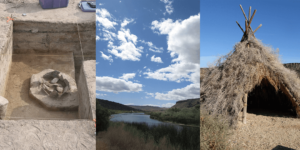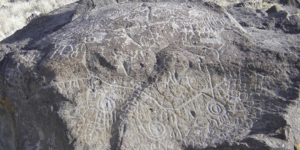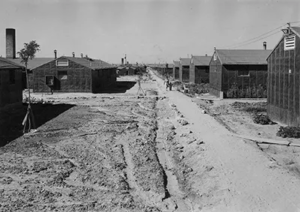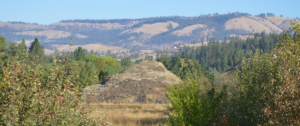Lifelong Idahoans know, and new arrivals and visitors quickly learn, that Idaho is steeped in a rich cultural history. May is National Historic Preservation Month, a time to celebrate our nation’s heritage though historic places. Established in 1973 by the National Trust for Historic Preservation, the month-long event is co-sponsored by state historical societies, local preservation organizations, businesses and civic groups across the country. This year, the Idaho Conservation League invites you to explore Idaho’s cultural heritage by visiting one (or many!) of the historic sites ICL is highlighting during the National Historic Preservation Month.
Celebration Park
What better way to celebrate National Historic Preservation Month than with a trip to Idaho’s first and only archaeological park – Celebration Park! Established in 1989, Celebration Park is located along the Snake River and within the Morley Nelson Snake River Birds of Prey National Conservation Area in Canyon County. At the park, visitors are exposed to a wide variety of cultural resources dating from 10,000 years ago to the historic period associated with Idaho’s early mining and railroad industries. Highlights include a walk through basalt deposited during the Bonneville flood, views of petroglyphs 100 to 10,000 years old, and a walking tour of the historic Guffey Railroad Bridge. You can also learn about Paleolithic and Archaic lifeways and try your hand at throwing a dart with an atlatl, a device used to hunt megafauna like mammoth and bison.

Map Rock
While you are in Canyon County visiting Celebration Park, we recommend a side trip to Map Rock, a large basalt boulder that contains numerous petroglyphs (etched carvings) created by Shoshone-Bannock peoples long before European contact. Some petroglyphs are estimated to date back 12,000 years. While we aren’t certain about the purpose of the carvings or what the images represent, Map Rock contains images that depict the Snake and Salmon Rivers, as well as many animals found on the Idaho landscape. You can learn more about Map Rock at the Celebration Park Visitor’s Center.
Despite the fact that the giant petroglyph site has been famous in the region for some time, Map Rock was only designated as a National Historic Site in 2012. Hundreds of other rock petroglyphs and pictographs can also be found in the boulder fields along the Snake and Salmon rivers.

Minidoka National Historic Site
The Minidoka National Historic Site documents a sad and shameful period of American history that should never be forgotten. Following Japan’s attack on Pearl Harbor, President Franklin D. Roosevelt signed Executive Order 9066, which forced more than 120,000 people of Japanese ancestry to leave their established homes and communities and placed them in one of ten internment camps scattered across the United States.
The Minidoka War Relocation Center was constructed in Jerome County and was locally known as “Hunt Camp,” as it was near the town of Hunt, Idaho. During the camp’s occupation, it was the seventh largest city in the state with nearly 9,400 people living in squalid conditions at the camp’s peak population. Minidoka was added to the National Register in 1979 and became the 385th unit of the National Park Service in 2001.

As visitors enter the site, they are met by a reconstructed guard tower and honor roll that commemorates the nearly 1,000 Japanese (Nisei) from Minidoka who served in the war and those who died as a result of their service to the United States during World War II. The stark location both serves as a reminder of the deep isolation and separation felt by the camp’s inhabitants and reminds us of our obligation today to protect the rights of all Americans, no matter their background or appearance. The National Park Service maintains numerous original buildings on the site, including a mess hall, fire station, and living quarters. The Visitor Center opens for the 2022 season on May 27th.

Nez Perce National Historical Park
Spanning four states (Idaho, Montana, Oregon, and Washington) and consisting of 38 locations, the Nez Perce National Historical Park highlights key moments, locations, and personages central to the history of the Nez Perce (Nimiipuu) people. The park was established by an act of Congress in 1965 and the National Park Service administers 9 of the 38 sites. The Spalding Visitor Center is located ten miles east of Lewiston, Idaho on U.S. Highway 95.
There are numerous activities for visitors at the Spalding Visitor Center, ranging from viewing the park film Of One Heart, which provides an introduction to the Nimiipuu story, to exploring the historic area on four short interpretive trails. Historical sites include the Watson’s Store, remnants of the Spalding Mission, and archaeological remains of the gristmill (a mill for grinding grain) and sawmill. Restrooms and picnic tables are also available.

The numerous park sites shed light on the history of the Nimiipuu people by providing educational information on the lives of important individuals, battles, and geographic features central to Nimiipuu culture. Creation stories serve as the foundation and core of every culture, and the Heart of the Monster near present day Kamiah, Idaho is the geographic formation that identifies where Iceye’ye (Coyote) killed a monster who was eating all the animals.

The legend tells how Iceye’ye tricked the monster into inhaling Coyote, allowing Iceye’ye to run into the monster’s mouth and down its throat. Iceye’ye then began cutting away slabs of fat and gave them to the people Monster had swallowed, eventually cutting away the heart and throwing the bones and parts to lands far and wide, creating the different tribes of the region. When Fox pointed out that Iceye’ye had left nothing to create people who would live in the immediate locality, Iceye’ye washed his hands and sprinkled the bloody wash water around the local regions and created the Nimiipuu. This very abbreviated version of the creation legend is more fully told and experienced by visiting the site.
When you visit the Spalding Visitor Center (which includes the Lapwai Mission Cemetery) and other park locations, please remember these areas are sacred ground. Visitors are asked to respect the tribal cemeteries within park boundaries by heeding the following regulations:
- Walk or stand on pathways or between graves, not directly atop of them.
- Eat and prepare food and drinks outside the boundaries of the cemetery.
- Do not take rubbings or markings from headstones.
- Do not touch the headstones.
- Leave all items on the graves in place and undisturbed.
- Recreate outside the boundaries of the cemetery.
- Adults, please accompany your children into the cemetery.
- Pay homage to those buried here between dawn and dusk. The park is closed after dark.
- Report any damage or suspected violation to the National Park Service at (208) 843-7001.
Although we celebrate National Historic Preservation Month during May, Idaho’s rich cultural heritage and history is accessible for all year-round. Many of the state’s interpretive sites provide both educational information and recreation opportunities, and are found on public lands from Bonners Ferry in the north to Preston in the south. We encourage you to take advantage of these wonders and share in what makes us more than Americans or Idahoans. Reach into the past to discover and experience our shared humanity.
To learn more about educational and recreational opportunities on Idaho’s public lands, sign up for our public lands campaign updates.

